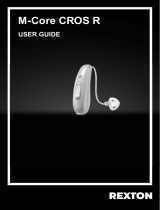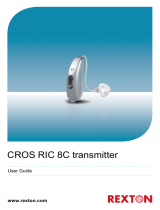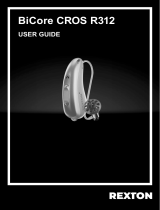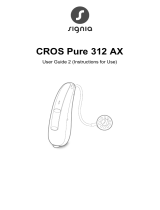Page is loading ...

M-Core CROS R
USER GUIDE 2
(Instructions for Use)

CAUTION
It is important to read this user guide and the
user guide 1 (safety manual) thoroughly and
completely. Follow the safety information to
avoid damage or injury.
2

CONTENT
Welcome 5
Your CROS transmitter 6
Components and names 8
Controls 10
Hearing programs 11
Signal tones 12
Batteries 13
Battery size and handling tips 13
Replacing batteries 14
Daily use 15
Turning on and off 15
Switching to standby mode 16
Inserting and removing the transmitter 17
Changing the hearing program 20
Bluetooth 21
Maintenance and care 22
Transmitter 22
Ear pieces 23
Professional maintenance 25
3

Further information 26
Safety information 26
Accessories 26
Explanation of symbols 26
Troubleshooting 28
Conformance information 29
Country-specific information 31
Important safety information 32
Personal safety 32
Product safety 35
Service and warranty 37
4

WELCOME
Thank you for choosing one of our hearing instrument
accessories.
This guide, along with support from your Hearing Care
Professional, will help you understand the advantages and
greater quality of life this accessory offers.
CAUTION
It is important to read this user guide thoroughly and
completely. Follow the safety information to avoid
damage or injury.
5

YOUR CROS TRANSMITTER
CROS solutions are designed for people with profound
hearing loss in one ear which can not be aided with a
hearing instrument. A CROS transmitter worn on this ear
captures sound from this side and transmits it to the hearing
instrument on the other ear. This allows the wearer of the
hearing instrument to hear sounds from both sides.
CROS transmitter hearing instrument
6

Two solutions are available:
႑CROS solution:
For people with normal hearing in one ear and profound
hearing loss in the other. Sounds from the side with
hearing loss are captured and transmitted wirelessly to
the good-hearing side.
႑BiCROS solution:
For people with profound hearing loss in one ear and less
severe hearing loss in the other. Sounds from the more
severe hearing loss side are captured and transmitted
wirelessly to the better-hearing side. The hearing
instrument processes and amplifies the sounds from both
sides.
The CROS transmitter works with our specific wireless
hearing instruments. Your Hearing Care Professional will
advise you on the compatible models.
NOTICE
This user guide only applies to the CROS transmitter.
Your hearing instrument has a separate user guide.
7

COMPONENTS AND NAMES
ᇀ
ᆿ
ᆺᆻ
ᆽ
ᆾ
ᆼ
ᆺ
Ear piece
ᆻ
Receiver
ᆼ
Receiver cable
ᆽ
Microphone
openings
ᆾ
Rocker switch (control, on/off
switch)
ᆿ
Battery compartment
ᇀ
Side indicator (red = right ear,
blue = left ear) and receiver
connection
Ear piece, retention receiver and receiver cable are only
used to hold the device on the ear. No sound is played.
8

You can use the following standard ear pieces:
Standard ear pieces Size
Click Sleeve (vented or closed)
Click Dome™ single
(open or closed)
Click Dome semi-open
Click Dome double
You can easily exchange the standard ear pieces. Read more
in section "Maintenance and care".
Custom-made ear pieces
Custom shell
Click Mold™
9

CONTROLS
With the rocker switch you can, for example, switch hearing
programs. The Hearing Care Professional has programmed
your desired functions to the rocker switch.
10

Rocker switch function L R
Press briefly:
Program up/down
Press for about 2 seconds:
Program up/down
Press for more than 3 seconds:
Turn on/off
L = Left, R = Right
You can also use a remote control to change hearing
programs and adjust the volume of your hearing
instruments. With our smartphone app you have even
more control options.
HEARING PROGRAMS
1
2
3
4
5
6
11

Read more in section "Changing the hearing program".
SIGNAL TONES
Signal tones of the CROS transmitter - like a low battery
beep - are sent to the hearing instrument.
Ask your Hearing Care Professional to configure the signal
tones.
12

BATTERIES
When the battery is low the sound becomes weaker or you
will hear an alert signal. The battery type will determine how
long you have to replace the battery.
BATTERY SIZE AND HANDLING TIPS
Ask your Hearing Care Professional for recommended
batteries.
Battery size: 312
႑Always use the correct battery size for your device.
႑Remove the batteries if you intend not to use the device
for several days.
႑Always carry spare batteries.
႑Remove empty batteries immediately and follow your
local recycling rules for battery disposal.
13

REPLACING BATTERIES
Removing the battery:
;Open the battery compartment.
;Use the magnet stick to pull out the
battery. The magnet stick is available
as an accessory.
Inserting the battery:
;If the battery has a protective film, remove it
only when you are ready to use the battery.
;Insert the battery with the "+" symbol
facing up (refer to the picture).
Carefully close the battery compartment. If you feel
resistance, the battery is not inserted correctly.
;Do not attempt to close the battery compartment by force.
It can be damaged.
14

DAILY USE
TURNING ON AND OFF
You have the following options to turn your device on or off.
Via battery compartment:
;Turning on: Close the battery compartment.
The default volume and hearing program are set.
;Turning off: Open the battery compartment to the first
catch.
Via rocker switch:
;Turning on: Press and hold the lower
part of the rocker switch until the startup
melody starts to play. Release the rocker
switch while the melody is playing.
The default volume and hearing program
are set.
ON
;Turning off: Press and hold upper or
lower part of the rocker switch for
several seconds. A power down melody
is played.
OFF
OFF
15

SWITCHING TO STANDBY MODE
Via remote control or smartphone app, you can switch
your device to standby mode. This mutes the device. When
you leave standby mode, the previously used volume and
hearing program are set.
Note:
႑In standby mode, the device is not turned off completely.
It draws some power.
Therefore we recommend to use standby mode only for a
short period of time.
႑If you want to leave standby mode, but the remote control
or app is not at hand: Turn your device off and on again
(via rocker switch or by opening and closing the battery
compartment). In this case, the default volume and
hearing program are set.
16

INSERTING AND REMOVING THE TRANSMITTER
Colored markers indicate the side:
႑red marker = right ear
႑blue marker = left ear
Inserting:
;For Click Sleeves, take care that the
bend of the Click Sleeve is in line with
the bend of the receiver cable.
Correct:
Incorrect:
17

;Hold the receiver cable at the bend closer to the
ear piece.
;Carefully push the ear piece in
the ear canal ᆺ.
;Twist it slightly until it sits well.
Open and close your mouth to
avoid accumulation of air in the
ear canal.
;Lift the device and slide it over
the top of your ear ᆻ.
CAUTION
Risk of injury!
;Insert the ear piece carefully and not too deeply
into the ear.
႑It may be helpful to insert the right device with the
right hand and the left device with the left hand.
႑If you have problems inserting the ear piece,
use the other hand to gently pull your earlobe
downwards. This opens the ear canal and eases
insertion of the ear piece.
18

The optional retention strand helps to securely retain the
ear piece in your ear. To position the retention strand:
;Bend the retention strand and position
it carefully into the bottom of the bowl
of your ear (refer to the picture).
Removing:
;Lift the device and slide it over
the top of your ear ᆺ.
;If your device is equipped with
a custom shell or a Click Mold,
remove it by pulling the small
removal cord toward the back
of your head.
;For all other ear pieces: Grip the receiver in the ear canal
with two fingers and pull it carefully out ᆻ.
Do not pull the receiver cable.
19

CAUTION
Risk of injury!
;In very rare cases the ear piece could remain
in your ear when removing the device. If this
happens, have the ear piece removed by a medical
professional.
Clean and dry your device after usage. Read more in section
"Maintenance and care".
CHANGING THE HEARING PROGRAM
Depending on the listening situation, your device
automatically adjust their sound.
Your device may also has several hearing programs which
allow you to change the sound, if needed. An optional signal
tone can indicate the program change.
;To change the hearing program, press the rocker switch
briefly.
Refer to section "Controls" for the setting of the rocker
switch. Refer to section "Hearing programs" for a list of
your hearing programs.
The default volume is applied.
20
/
















